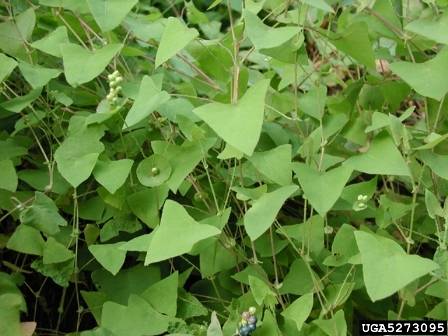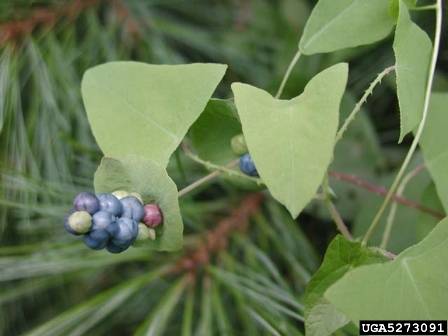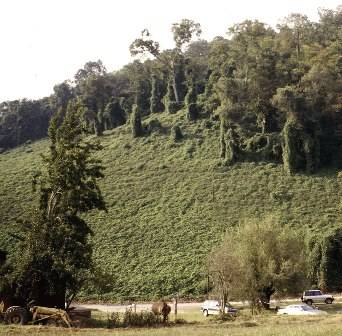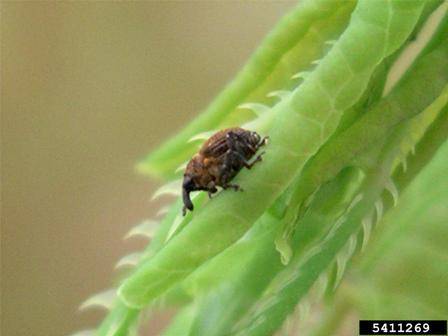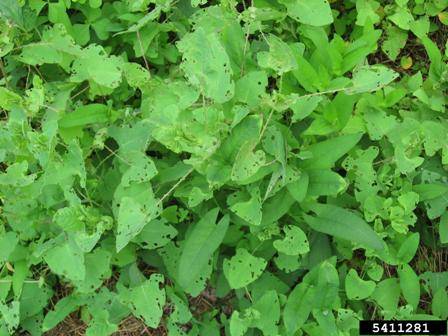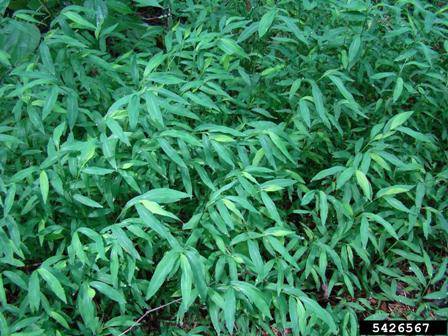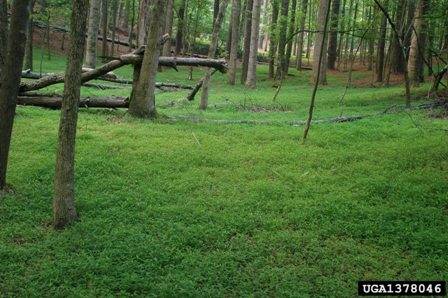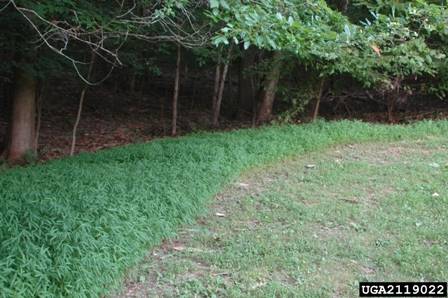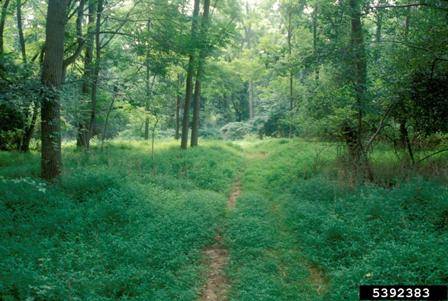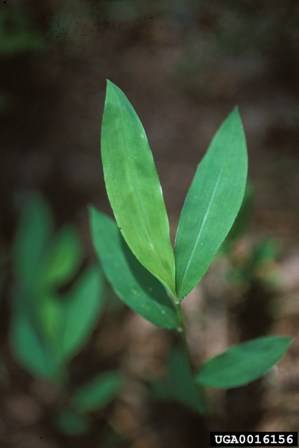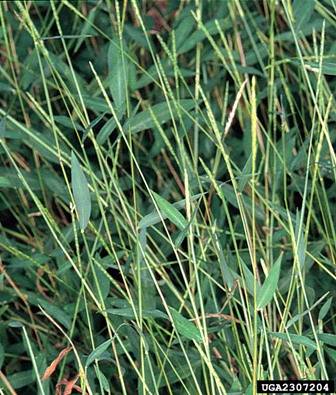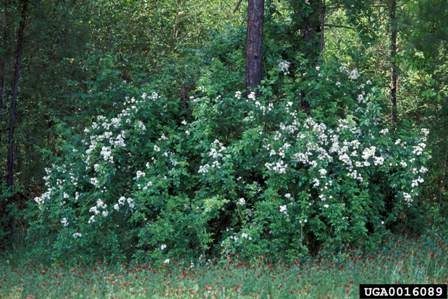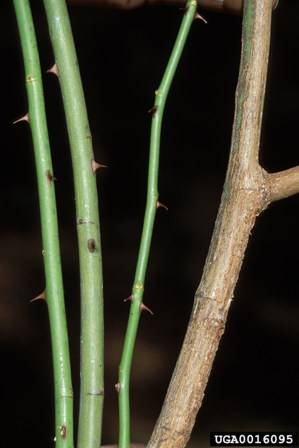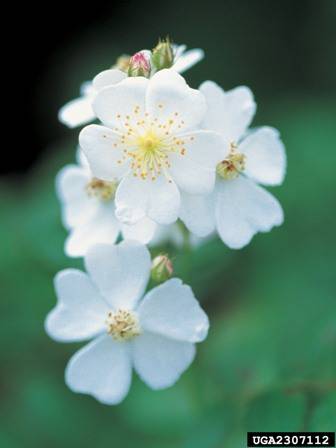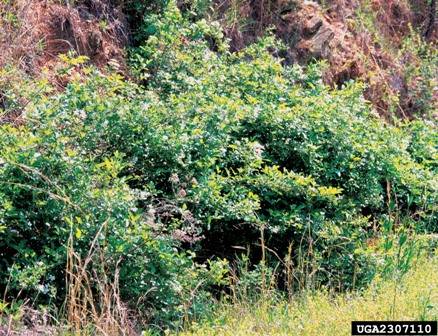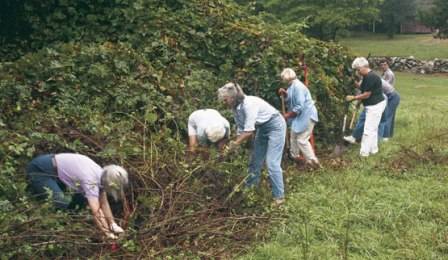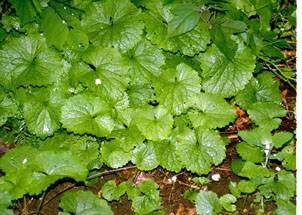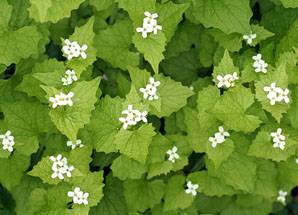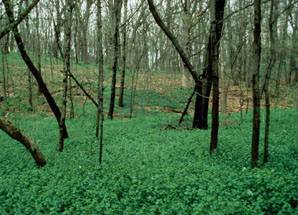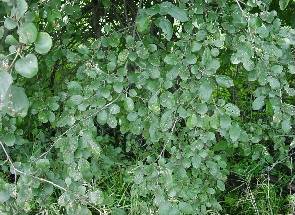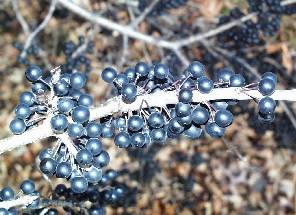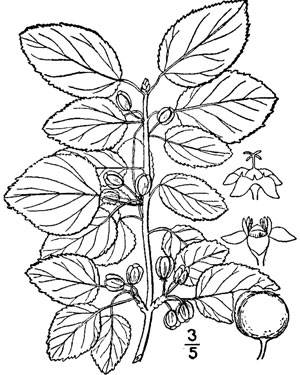History & Distribution | Biology & Habitat | Identification | Ecological Impacts | Human Health Impacts | Control
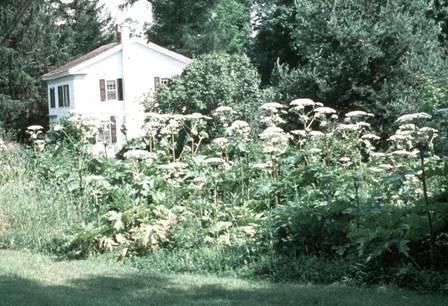
One of New York’s most striking and dangerous invasive plants, the giant hogweed (Heracleum mantegazzianum) can make a case of poison ivy seem like a mild rash.
History and Introduction
A member of the carrot and parsley family of plants (Apiaceae), giant hogweed is native to the Caucasus region of Eurasia. Because of its unique size and impressive flower head, the plant was originally introduced to Great Britain as an ornamental curiosity in the 19th century. The plant is named after the mythological god Hercules (he of robust size and strength). It was later transported to the United States and Canada as a showpiece in arboreta and Victorian gardens (one of the first North American plantings of giant hogweed was in gardens near Highland Park in the City of Rochester, New York). It was also a favorite of beekeepers because of the size of its flower heads (the amount of food for bees is substantial). A powder made from the dried seeds is also used as a spice in Iranian cooking. Unfortunately, as with so many invasive plants, giant hogweed escaped cultivation and has now become established in a number of areas in New York (see map, below), as well as in Connecticut, the District of Columbia, Illinois, Maine, Maryland, Massachusetts, Michigan, Ohio, Oregon, Pennsylvania, Washington, Wisconsin, and Ontario and Vancouver Island in Canada. Because of its public health hazard potential and, to a lesser extent, to its potential ecological impacts, giant hogweed is on the federal noxious weed list and several state lists of prohibited plant species.
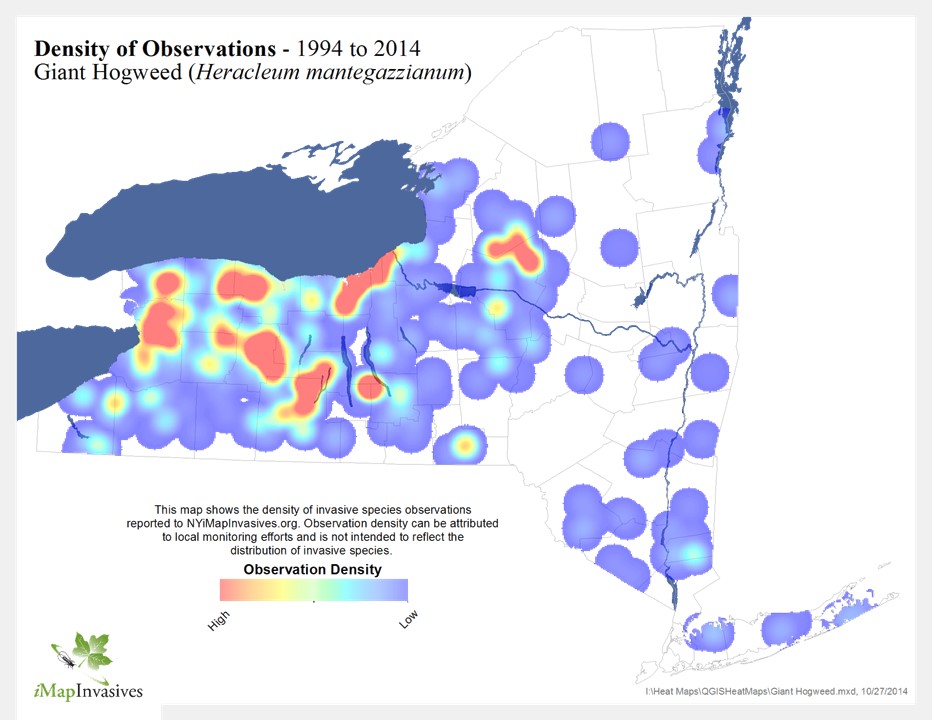
Biology & Habitat
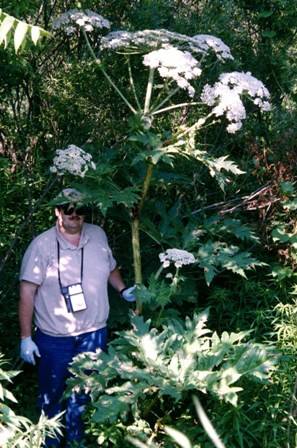
Giant hogweed (Heracleum mantegazzianum) is a member of the carrot or parsley family, Apiaceae (Umbelliferae). Except for its size, the plant can be mistaken for a number of native, noninvasive plants such as cow parsnip (Heracleum lanatum), Angelica (Angelica atropurpurea), and poison hemlock (Conium maculatum). Of these, the plant most likely to be misidentified as giant hogweed is cow parsnip. A fourth, not-so-innocuous, invasive giant-hogweed imposter found throughout North America is wild parsnip (Pastinaca sativa). Information on how to distinguish these giant hogweed wannabees from the real thing can be found later in this profile.
Giant hogweed is a perennial herb with tuberous root stalks. It survives from one growing season to another by forming perennating buds (surviving from season to season) and enduring a period of dormancy during the winter. The plant develops numerous white flowers that form a flat-topped, umbrella-shaped head up to two and a half feet across, resembling “Queen Anne’s Lace on steroids.” Flowers form from late-spring through mid-summer. Numerous (up to 100,000), half inch long, winged, flattened oval seeds form in late-summer. These seeds, originally green, turn brown as they dry and can be spread by animals, surface runoff of rain, or on the wind, establishing new colonies. Seeds can remain viable in the soil for up to 10 years. The plant’s stems die in the fall and remain standing through the winter, topped with the huge, brown dead flower heads.
Giant hogweed’s thick hollow stems are generally one to three inches in diameter but can reach four inches. Also impressive are the plant’s lobed, deeply incised compound leaves, which can reach up to five feet in width. The plant may grow to 15 to 20 feet in height.
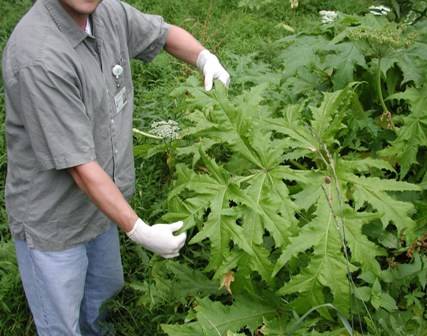
Identification 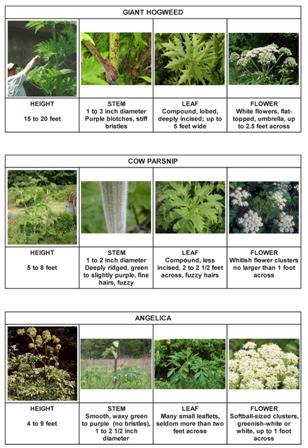
As mentioned earlier, there are several plants in New York and the Northeast that can be mistaken for giant hogweed. Key features for distinguishing these plants from giant hogweed are explained below. Click the identification tables to enlarge.
Giant hogweed may grow to 15 to 20 feet in height. Stems are 1 to 3 inches in diameter, but may reach 4 inches. Stems are marked with dark purplish blotches and raised nodules. Leaf stalks are spotted, hollow, and covered with sturdy bristles (most prominent at the base of the stalk). Stems are also covered with hairs but not as prominently as the leaf stalks. Leaves are compound, lobed, and deeply incised; can reach up to 5 feet in width. Numerous white flowers form a flat-topped, umbrella-shaped head up to two and a half feet across. [See ID table 1]
Native Cow parsnip, while resembling giant hogweed, grows to only five to eight feet tall. The deeply ridged stems can be green or slightly purple, do not exhibit the dark purplish blotches and raised nodules of hogweed, and only reach one to two inches in diameter, contrasted with hogweed stems which can reach three to four inches in diameter. Where giant hogweed has coarse bristly hairs on its stems and stalks, cow parsnip is covered with finer hairs that give the plant a fuzzy appearance. Both sides of the leaves exhibit these hairs but they are predominantly on the underside of the leaves. In contrast to hogweed’s two- to two-and-a-half-foot flower heads, cow parsnip flower clusters are less than a foot across. The size difference carries over into leaf size with hogweed’s five foot, deeply incised leaves replaced by leaves that are less incised and only two- to two-and-a-half-foot across.
Native purple-stemmed Angelica is more easily differentiated from giant hogweed by its smooth, waxy green to purple stems (no bristles, no nodules), and its softball-sized clusters of greenish-white or white flowers, seldom reaching a foot across. As with cow parsnip, Angelica is much shorter than giant hogweed, usually no more than eight feet tall. Angelica leaves are comprised of many small leaflets and seldom reach more than two feet across.
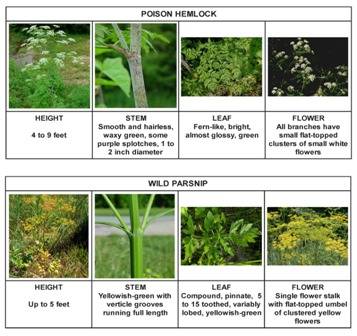 Poison hemlock, a non-native biennial, is also shorter than giant hogweed, growing to only four to nine feet in height. While the stem has some purple blotches, it is waxy and the entire plant (stems, stalks, leaves) is smooth and hairless. The leaves are dramatically different from those of hogweed, being fernlike and a bright, almost glossy, green. All branches have small flat-topped clusters of small white flowers. Another distinguishing characteristic is poison hemlock’s unpleasant mouse-like odor. The entire plant is toxic, and the volatile alkaloids can even be toxic when inhaled. [See ID Table 2]
Poison hemlock, a non-native biennial, is also shorter than giant hogweed, growing to only four to nine feet in height. While the stem has some purple blotches, it is waxy and the entire plant (stems, stalks, leaves) is smooth and hairless. The leaves are dramatically different from those of hogweed, being fernlike and a bright, almost glossy, green. All branches have small flat-topped clusters of small white flowers. Another distinguishing characteristic is poison hemlock’s unpleasant mouse-like odor. The entire plant is toxic, and the volatile alkaloids can even be toxic when inhaled. [See ID Table 2]
Wild parsnip, like giant hogweed, is of special concern because it, too, can cause phytophotodermititis, only not usually as severe as that of giant hogweed. This plant can be found extensively throughout NY’s Southern Tier, in the region east of Lake Ontario, some Central and Western New York counties, parts of the Catskills and counties east of the Hudson River. Unlike the perennial giant hogweed, wild parsnip is biennial, producing a rosette of leaves close to the ground in its first year and a single flower stalk with a flat-topped umbel with clusters of yellow flowers in its second year. The plant reproduces by means of the seeds of these flowers; it does not re-grow from its root as does giant hogweed. Wild parsnip is much smaller than giant hogweed, seldom exceeding 5 feet in height. Wild parsnip stems are yellowish-green with vertical grooves running their length. Wild parsnip has compound pinnate leaves with 5 to 15 toothed and variably lobed yellowish-green leaves.
Ecological Impacts
Colonies of giant hogweed can become quite dense owing to the plant’s prolific seed production and rapid growth rate. Such dense stands crowd out slower growing plants, the thick hogweed canopy displacing native plants that need direct sunlight to grow. The decreased abundance of beneficial native plants can reduce the utility of the area for wildlife habitat. When riparian plants are displaced, stream bank erosion can increase and streambeds can become covered with silt.
Human Health Impacts
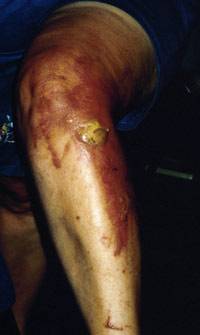
Giant hogweed is one of a very few North American invasive plants that can cause human health impacts as well as ecological damage, causing a significant reaction when humans come in direct contact with the plant. Spread of this plant in urban and suburban areas is viewed as an incipient public health hazard. [Wild parsnip can result in almost as severe reactions.]
Soon after humans bruise the leaves or stems of the more common poison ivy, poison oak, and poison sumac, an allergic reaction to the plants’ poisonous oil (akin to carbolic acid) causes significant skin irritation, itching, rashes and open sores. In the case of giant hogweed, however, simply simply brushing against the plant’s leaves or stems does not cause the skin inflammation. For giant hogweed to affect a person, sap from a broken stem or crushed leaf, root, flower or seed must come into contact with moist skin (perspiration will suffice) with the skin then being exposed to sunlight. Irritation is not immediate, but will usually appear within one to three days after exposure. This form of skin irritation (dermatitis) is called “phytophotodermatitis”. The plant’s clear, watery sap contains a glucoside called furanocoumarin that is a psoralen. Psoralens sensitize the skin to ultraviolet radiation and can result in severe burns, blistering, painful sores, and purplish or blackened scars. These phototoxic effects are the result of the binding of the psoralens to nuclear DNA under the influence of ultraviolet irradiation, and the subsequent death of affected cells.
The first signs of giant hogweed-caused photodermatitis are when the skin turns red and starts itching. Within 24 hours, burn-like lesions form, followed by large, fluid filled blisters within 48 hours. The initial irritation usually will subside within a few days, but affected areas may remain hypersensitive to ultraviolet light for many years and re-eruptions of lesions and blisters may occur. On rare occasions, particularly in very sensitive individuals, the burns and blisters may be bad enough to require hospitalization. A side effect of exposure to the psoralens is the production of excessive amounts of melanin in the skin, resulting in residual brown blotches called hyper-pigmentation; scars and brown to black blotches may last for several years. The worst risk of exposure to giant hogweed is to one’s eyes – getting even minute amounts of the sap in the eyes can result in temporary or even permanent blindness. Medical help should be sought immediately; by the time symptoms of burning and hypersensitivity to sunlight are apparent, the damage could already be irreversible.
The only known antidote to contact with the sap is to immediately wash skin thoroughly with soap and water, removing the sap and hopefully preventing any reaction with subsequent exposure to sunlight. Once the irritation begins, medical advice should be sought. Treatment with prescription topical steroids early on may reduce the severity of a person’s reaction. It will also be important to cover the burns and blisters with light sterile dressings to prevent infection. Long-term, use of sunblock in subsequent years may be required to prevent sensitization by sunlight again.
People most at risk include landscape technicians and yard maintenance laborers who may come in contact with the sap when cutting the plant down or using line trimmers to control new growth. Children breaking off the long, bamboo-like stems to use as play swords are also at great risk. However, sometimes direct contact with the plant is not necessary for a reaction. Farmers have been known to develop symptoms when they touch cows who have gotten the sap on their skin while grazing (cows, themselves, seem impervious to the sap). The best prevention measure is to wear long sleeves and long-legged pants when contact with the plant is a possibility.
Control
If it weren’t for giant hogweed’s public health impacts, the plant most likely would not be worth the effort of controlling it. Although it does have ecologic impacts, they are not as severe as many other wetland invasive plants. However, the health impacts can be severe and the plant has found itself on the federal noxious weed list and several state lists, as well. It is a particular target of parks and transportation/highway departments’ invasive plant eradication efforts. Such eradication programs can incorporate a combination of physical removal and chemical control. If undertaken properly, such programs can be done without harm to humans or damage to the environment. Recently some landowners have been known to refuse permission to allow highway departments to chemically treat giant hogweed thickets. It is believed that this is usually a case of lack of knowledge on the landowner’s part.
Giant hogweed is very difficult to eradicate. Although the stems, stalks, leaves and flowers can be killed with a number of common selective herbicides, such as 2,4-D (the third most-often used herbicide in North America), dicamba (a benzoic acid herbicide), TBA (terbuthylazine) and MCPA, these herbicides are not effective at killing the plant’s tuberous perennial roots. Another common, selective broadleaf herbicide, triclopyr (a common brand name is Brush-B-Gone®), is also effective, particularly when applied directly to the entire surface of leaves and stems during periods of active growth; numerous applications may be needed to kill the root stalk. Early application (during the bud stage and the period of active plant growth) of glyphosate (commonly sold under the trade names Rodeo® and Roundup®) is most effective. Care should be taken when using any herbicides to control giant hogweed; particular care should be taken when using glyphosate as it is nonselective and will kill both the hogweed and desirable plants such as grass. Before using any herbicide, check with your state environmental regulatory agency to find out which products are licensed for homeowner use in your state.
For those hesitant to utilize herbicides, giant hogweed can be managed using various “cultural” methods. Unfortunately, owing to the plant’s persistence and spread by blowing seeds, such control can take many seasons worth of effort to achieve 100% control. Individual plants can be dug out, removing the entire rootstalk, a difficult process, particularly in patches where the plant has spread by root growth. Mowing, cutting and use of line trimmers can be used to remove a standing crop and starve the rootstalk. Unfortunately, unless performed numerous times during a season, mowing only serves to stimulate budding on the rootstalk. All of these methods should be done with extreme care and only while wearing protective clothing and eye protection. Skin contact with soiled clothing should also be avoided. Biocontrol by grazing cows and pigs (which are apparently not affected by the plant’s sap) may also help to manage but not eliminate the plant. Care should be taken not to get sap on uncovered skin when touching livestock after the animals contact crushed or bruised hogweed.
Control of wild parsnip is less difficult than controlling giant hogweed because as a biennial, wild parsnip reproduces only from seed, not from its rootstock. This plant can be controlled by cutting the stem from the root below ground level with a shovel, spade or machete before the seed head matures.
If you find giant hogweed in New York State, you are encouraged to call New York State’s Department of Environmental Conservation (DEC) Giant Hogweed Hotline:
845-256-3111
Reports
2014 Giant Hogweed Annual Report
The DEC Forest Health giant hogweed crews and partner agencies (Oswego SWCD and four PRISMs (Partnerships for Regional Invasive Species Management) — APIPP, CRISP, Lower Hudson, and SLELO) had an extremely productive field season which resulted in the following achievements:
- 1,495 (93%) of the 1,613 active sites located throughout 47 counties in NY State were visited
- 501 sites previously infested (28% of all sites), no longer had any giant hogweed plants
- 239 of these sites have been monitored for 3 years with no plants found and we now consider them eradicated
- 516 sites had only 1-19 plants (34% of active sites). The sites are getting smaller in size
- 556 sites were treated with root-cutting- 22,255 plants controlled
- 551 sites were treated with herbicide- 397,000 plants sprayed
- 316 sites were treated with flower/seed head removal- 7,677 flower/seed heads removed
- The hotline, based out of the New Paltz DEC office, received 2,491 calls and emails
2017 Giant Hogweed Annual Report
View the 2017 Report
- 2,253 confirmed sites in 49 counties (no sites discovered in any new counties)
- 1,755 of the confirmed sites are in the monitor or treatment stage
- 123 sites newly designated as eradicated for a total of 498 eradicated sites (no plants for 3 consecutive years)
- 1,804 sites (80%) have 0-99 plants
- 140 new sites identified
- 1,872 sites visited
- 1,233 sites controlled – approximately 668,000 plants controlled
- 1,106 phone calls and e-mails responded to by GH Information Line staff
- 205,857 visits to DEC’s GH webpages




